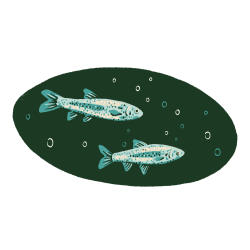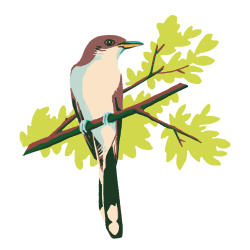RÍO GRANDE SILVERY MINNOW
 About 25 years ago, the collapse of the Río Grande silvery minnow population alerted people that the river itself needed water. Despite a decades-long effort to reshape water use with this tiny fish in mind, the silvery minnow survives today only by human intervention. Biologists capture eggs by holding a box covered in a tightly knit screen in the river during the spring runoff for captive breeding. They also often save adults, about three and a half inches in length, from drying stretches of the Río Grande. The most important thing for the minnow and other species along the Río is to get more flexibility in how and when water flows, says Debra Hill, Río Grande Basin recovery program supervisor with the U.S. Fish and Wildlife Service.
About 25 years ago, the collapse of the Río Grande silvery minnow population alerted people that the river itself needed water. Despite a decades-long effort to reshape water use with this tiny fish in mind, the silvery minnow survives today only by human intervention. Biologists capture eggs by holding a box covered in a tightly knit screen in the river during the spring runoff for captive breeding. They also often save adults, about three and a half inches in length, from drying stretches of the Río Grande. The most important thing for the minnow and other species along the Río is to get more flexibility in how and when water flows, says Debra Hill, Río Grande Basin recovery program supervisor with the U.S. Fish and Wildlife Service.
YELLOW-BILLED CUCKOO
 As Elephant Butte Lake has shrunk, once-submerged habitat has returned to the river corridor, helping the threatened yellow-billed cuckoo to make a comeback. A booming population along that reservoir has even spread north into Albuquerque, where projects have also rebuilt habitat. “It’s young birds being dispersed and looking for habitat that’s not quite as crowded,” Hill says. Watch for a lean bird about 10 to 12 inches tall with a string of white spots down a long, dark tail and a bright yellow bill. Males call out in a hollow-sounding ka-ka-ka-kow-kow-kow-kowlp kowlp kowlp.
As Elephant Butte Lake has shrunk, once-submerged habitat has returned to the river corridor, helping the threatened yellow-billed cuckoo to make a comeback. A booming population along that reservoir has even spread north into Albuquerque, where projects have also rebuilt habitat. “It’s young birds being dispersed and looking for habitat that’s not quite as crowded,” Hill says. Watch for a lean bird about 10 to 12 inches tall with a string of white spots down a long, dark tail and a bright yellow bill. Males call out in a hollow-sounding ka-ka-ka-kow-kow-kow-kowlp kowlp kowlp.
NEW MEXICO MEADOW JUMPING MOUSE
 Known for its snow geese and sandhill cranes, Bosque del Apache National Wildlife Refuge is also home to the New Mexico meadow jumping mouse, which lives in wet, dense grasses or willows along perennial streams and the Río Grande. With a tail making up half its seven- to nine-inch length, the endangered mouse uses its long back feet to leap as far as three feet. Generally nocturnal, the meadow jumping mouse fattens itself on seeds for a nine-month hibernation. However, cattle grazing and water diversions have depleted their streamside habitats throughout the Southwest. The White Mountains in southern New Mexico host one of the last populations, but in 2018, after a 40-year absence, the mice were also spotted in Valles Caldera National Preserve.
Known for its snow geese and sandhill cranes, Bosque del Apache National Wildlife Refuge is also home to the New Mexico meadow jumping mouse, which lives in wet, dense grasses or willows along perennial streams and the Río Grande. With a tail making up half its seven- to nine-inch length, the endangered mouse uses its long back feet to leap as far as three feet. Generally nocturnal, the meadow jumping mouse fattens itself on seeds for a nine-month hibernation. However, cattle grazing and water diversions have depleted their streamside habitats throughout the Southwest. The White Mountains in southern New Mexico host one of the last populations, but in 2018, after a 40-year absence, the mice were also spotted in Valles Caldera National Preserve.
CHIRICAHUA LEOPARD FROG
 That snoring sound coming from pools, streams, marshes, and even stock tanks in southwestern New Mexico could be the distinctive call of a Chiricahua leopard frog. The boldly patterned amphibian appears to have adapted to the Southwest’s routine flooding. They have been “observed sitting up on rocks, watching the waters roaring past, and then moving back into the system after the flood has passed,” notes Leland Pierce, a herpetologist with the New Mexico Department of Game and Fish. While a drier Southwest has already limited it to less than a quarter of their historic habitat, the leopard frog faces a new struggle in the form of a potentially fatal fungus infection.
That snoring sound coming from pools, streams, marshes, and even stock tanks in southwestern New Mexico could be the distinctive call of a Chiricahua leopard frog. The boldly patterned amphibian appears to have adapted to the Southwest’s routine flooding. They have been “observed sitting up on rocks, watching the waters roaring past, and then moving back into the system after the flood has passed,” notes Leland Pierce, a herpetologist with the New Mexico Department of Game and Fish. While a drier Southwest has already limited it to less than a quarter of their historic habitat, the leopard frog faces a new struggle in the form of a potentially fatal fungus infection.
PECOS SUNFLOWER
 The Pecos sunflower pops up along seeps and springs that form wet, saline meadows called ciénegas. A robust stand could see as many as 5,000 of their sunny blooms, but land and groundwater use have caused their numbers to dwindle. Still, Hill adds, “It’s one species that everyone can see driving by in September on I-25.” Look out in La Joya Wildlife Area and near Santa Rosa in eastern New Mexico, where the Blue Hole Ciénega Nature Preserve hosts one of the most important stands of these flowers, from late August to October.
The Pecos sunflower pops up along seeps and springs that form wet, saline meadows called ciénegas. A robust stand could see as many as 5,000 of their sunny blooms, but land and groundwater use have caused their numbers to dwindle. Still, Hill adds, “It’s one species that everyone can see driving by in September on I-25.” Look out in La Joya Wildlife Area and near Santa Rosa in eastern New Mexico, where the Blue Hole Ciénega Nature Preserve hosts one of the most important stands of these flowers, from late August to October.


